+ Open data
Open data
- Basic information
Basic information
| Entry | Database: PDB / ID: 7oy5 | ||||||
|---|---|---|---|---|---|---|---|
| Title | Crystal structure of GSK3Beta in complex with ARN25068 | ||||||
 Components Components | Glycogen synthase kinase-3 beta | ||||||
 Keywords Keywords |  TRANSFERASE / Inhibitor / TRANSFERASE / Inhibitor /  complex / GSK-3B complex / GSK-3B | ||||||
| Function / homology |  Function and homology information Function and homology informationregulation of microtubule anchoring at centrosome / negative regulation of glycogen (starch) synthase activity / neuron projection organization / negative regulation of mesenchymal stem cell differentiation / beta-catenin destruction complex disassembly / negative regulation of type B pancreatic cell development / superior temporal gyrus development / positive regulation of protein localization to cilium / negative regulation of glycogen biosynthetic process / negative regulation of dopaminergic neuron differentiation ...regulation of microtubule anchoring at centrosome / negative regulation of glycogen (starch) synthase activity / neuron projection organization / negative regulation of mesenchymal stem cell differentiation / beta-catenin destruction complex disassembly / negative regulation of type B pancreatic cell development / superior temporal gyrus development / positive regulation of protein localization to cilium / negative regulation of glycogen biosynthetic process / negative regulation of dopaminergic neuron differentiation / maintenance of cell polarity / positive regulation of protein localization to centrosome / : / positive regulation of mitochondrial outer membrane permeabilization involved in apoptotic signaling pathway / positive regulation of cilium assembly / negative regulation of protein acetylation / APC truncation mutants have impaired AXIN binding / AXIN missense mutants destabilize the destruction complex / Truncations of AMER1 destabilize the destruction complex / beta-catenin destruction complex /  tau-protein kinase / CRMPs in Sema3A signaling / heart valve development / regulation of microtubule-based process / regulation of protein export from nucleus / Beta-catenin phosphorylation cascade / Signaling by GSK3beta mutants / CTNNB1 S33 mutants aren't phosphorylated / CTNNB1 S37 mutants aren't phosphorylated / CTNNB1 S45 mutants aren't phosphorylated / CTNNB1 T41 mutants aren't phosphorylated / Maturation of nucleoprotein / cellular response to interleukin-3 / Wnt signalosome / negative regulation of protein localization to nucleus / negative regulation of TOR signaling / regulation of long-term synaptic potentiation / Disassembly of the destruction complex and recruitment of AXIN to the membrane / Maturation of nucleoprotein / AKT phosphorylates targets in the cytosol / negative regulation of calcineurin-NFAT signaling cascade / positive regulation of cell-matrix adhesion / regulation of axon extension / dopamine receptor signaling pathway / negative regulation of phosphoprotein phosphatase activity / regulation of dendrite morphogenesis / tau-protein kinase / CRMPs in Sema3A signaling / heart valve development / regulation of microtubule-based process / regulation of protein export from nucleus / Beta-catenin phosphorylation cascade / Signaling by GSK3beta mutants / CTNNB1 S33 mutants aren't phosphorylated / CTNNB1 S37 mutants aren't phosphorylated / CTNNB1 S45 mutants aren't phosphorylated / CTNNB1 T41 mutants aren't phosphorylated / Maturation of nucleoprotein / cellular response to interleukin-3 / Wnt signalosome / negative regulation of protein localization to nucleus / negative regulation of TOR signaling / regulation of long-term synaptic potentiation / Disassembly of the destruction complex and recruitment of AXIN to the membrane / Maturation of nucleoprotein / AKT phosphorylates targets in the cytosol / negative regulation of calcineurin-NFAT signaling cascade / positive regulation of cell-matrix adhesion / regulation of axon extension / dopamine receptor signaling pathway / negative regulation of phosphoprotein phosphatase activity / regulation of dendrite morphogenesis /  regulation of axonogenesis / establishment of cell polarity / regulation of axonogenesis / establishment of cell polarity /  tau-protein kinase activity / glycogen metabolic process / ER overload response / Constitutive Signaling by AKT1 E17K in Cancer / protein kinase A catalytic subunit binding / tau-protein kinase activity / glycogen metabolic process / ER overload response / Constitutive Signaling by AKT1 E17K in Cancer / protein kinase A catalytic subunit binding /  dynactin binding / dynactin binding /  NF-kappaB binding / Regulation of HSF1-mediated heat shock response / NF-kappaB binding / Regulation of HSF1-mediated heat shock response /  epithelial to mesenchymal transition / canonical Wnt signaling pathway / negative regulation of osteoblast differentiation / negative regulation of protein-containing complex assembly / positive regulation of autophagy / regulation of microtubule cytoskeleton organization / regulation of cellular response to heat / cellular response to retinoic acid / extrinsic apoptotic signaling pathway / negative regulation of extrinsic apoptotic signaling pathway via death domain receptors / extrinsic apoptotic signaling pathway in absence of ligand / presynaptic modulation of chemical synaptic transmission / epithelial to mesenchymal transition / canonical Wnt signaling pathway / negative regulation of osteoblast differentiation / negative regulation of protein-containing complex assembly / positive regulation of autophagy / regulation of microtubule cytoskeleton organization / regulation of cellular response to heat / cellular response to retinoic acid / extrinsic apoptotic signaling pathway / negative regulation of extrinsic apoptotic signaling pathway via death domain receptors / extrinsic apoptotic signaling pathway in absence of ligand / presynaptic modulation of chemical synaptic transmission /  excitatory postsynaptic potential / negative regulation of insulin receptor signaling pathway / positive regulation of protein export from nucleus / positive regulation of protein ubiquitination / Ubiquitin-dependent degradation of Cyclin D / hippocampus development / positive regulation of cell differentiation / GSK3B and BTRC:CUL1-mediated-degradation of NFE2L2 / peptidyl-threonine phosphorylation / Degradation of GLI2 by the proteasome / GLI3 is processed to GLI3R by the proteasome / positive regulation of protein-containing complex assembly / Degradation of beta-catenin by the destruction complex / tau protein binding / negative regulation of canonical Wnt signaling pathway / B-WICH complex positively regulates rRNA expression / excitatory postsynaptic potential / negative regulation of insulin receptor signaling pathway / positive regulation of protein export from nucleus / positive regulation of protein ubiquitination / Ubiquitin-dependent degradation of Cyclin D / hippocampus development / positive regulation of cell differentiation / GSK3B and BTRC:CUL1-mediated-degradation of NFE2L2 / peptidyl-threonine phosphorylation / Degradation of GLI2 by the proteasome / GLI3 is processed to GLI3R by the proteasome / positive regulation of protein-containing complex assembly / Degradation of beta-catenin by the destruction complex / tau protein binding / negative regulation of canonical Wnt signaling pathway / B-WICH complex positively regulates rRNA expression /  regulation of circadian rhythm / regulation of circadian rhythm /  beta-catenin binding / positive regulation of GTPase activity / beta-catenin binding / positive regulation of GTPase activity /  circadian rhythm / positive regulation of protein catabolic process / cellular response to amyloid-beta / Regulation of RUNX2 expression and activity / neuron projection development / positive regulation of neuron apoptotic process / positive regulation of proteasomal ubiquitin-dependent protein catabolic process / circadian rhythm / positive regulation of protein catabolic process / cellular response to amyloid-beta / Regulation of RUNX2 expression and activity / neuron projection development / positive regulation of neuron apoptotic process / positive regulation of proteasomal ubiquitin-dependent protein catabolic process /  p53 binding / presynapse / positive regulation of protein binding / insulin receptor signaling pathway / negative regulation of neuron projection development / p53 binding / presynapse / positive regulation of protein binding / insulin receptor signaling pathway / negative regulation of neuron projection development /  kinase activity kinase activitySimilarity search - Function | ||||||
| Biological species |   Homo sapiens (human) Homo sapiens (human) | ||||||
| Method |  X-RAY DIFFRACTION / X-RAY DIFFRACTION /  SYNCHROTRON / SYNCHROTRON /  MOLECULAR REPLACEMENT / Resolution: 2.57 Å MOLECULAR REPLACEMENT / Resolution: 2.57 Å | ||||||
 Authors Authors | Tripathi, S.K. / Balboni, B. / Demuro, S. / DiMartino, R. / Giabbai, B. / Storici, P. / Ortega, J. / Girotto, S. / Cavalli, A. | ||||||
 Citation Citation |  Journal: Eur.J.Med.Chem. / Year: 2022 Journal: Eur.J.Med.Chem. / Year: 2022Title: ARN25068, a versatile starting point towards triple GSK-3 beta /FYN/DYRK1A inhibitors to tackle tau-related neurological disorders. Authors: Demuro, S. / Sauvey, C. / Tripathi, S.K. / Di Martino, R.M.C. / Shi, D. / Ortega, J.A. / Russo, D. / Balboni, B. / Giabbai, B. / Storici, P. / Girotto, S. / Abagyan, R. / Cavalli, A. | ||||||
| History |
|
- Structure visualization
Structure visualization
| Structure viewer | Molecule:  Molmil Molmil Jmol/JSmol Jmol/JSmol |
|---|
- Downloads & links
Downloads & links
- Download
Download
| PDBx/mmCIF format |  7oy5.cif.gz 7oy5.cif.gz | 147.7 KB | Display |  PDBx/mmCIF format PDBx/mmCIF format |
|---|---|---|---|---|
| PDB format |  pdb7oy5.ent.gz pdb7oy5.ent.gz | 113.4 KB | Display |  PDB format PDB format |
| PDBx/mmJSON format |  7oy5.json.gz 7oy5.json.gz | Tree view |  PDBx/mmJSON format PDBx/mmJSON format | |
| Others |  Other downloads Other downloads |
-Validation report
| Arichive directory |  https://data.pdbj.org/pub/pdb/validation_reports/oy/7oy5 https://data.pdbj.org/pub/pdb/validation_reports/oy/7oy5 ftp://data.pdbj.org/pub/pdb/validation_reports/oy/7oy5 ftp://data.pdbj.org/pub/pdb/validation_reports/oy/7oy5 | HTTPS FTP |
|---|
-Related structure data
| Related structure data | 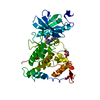 7oy6C  6h0uS S: Starting model for refinement C: citing same article ( |
|---|---|
| Similar structure data |
- Links
Links
- Assembly
Assembly
| Deposited unit | 
| ||||||||
|---|---|---|---|---|---|---|---|---|---|
| 1 |
| ||||||||
| Unit cell |
|
- Components
Components
| #1: Protein |  / GSK-3 beta / Serine/threonine-protein kinase GSK3B / GSK-3 beta / Serine/threonine-protein kinase GSK3BMass: 39930.922 Da / Num. of mol.: 2 Source method: isolated from a genetically manipulated source Source: (gene. exp.)   Homo sapiens (human) / Gene: GSK3B / Production host: Homo sapiens (human) / Gene: GSK3B / Production host:   Trichoplusia ni (cabbage looper) Trichoplusia ni (cabbage looper)References: UniProt: P49841,  tau-protein kinase, tau-protein kinase,  non-specific serine/threonine protein kinase non-specific serine/threonine protein kinase#2: Chemical | #3: Chemical | ChemComp-CL /  Chloride Chloride#4: Water | ChemComp-HOH / |  Water WaterHas ligand of interest | Y | |
|---|
-Experimental details
-Experiment
| Experiment | Method:  X-RAY DIFFRACTION / Number of used crystals: 1 X-RAY DIFFRACTION / Number of used crystals: 1 |
|---|
- Sample preparation
Sample preparation
| Crystal | Density Matthews: 3.97 Å3/Da / Density % sol: 69.04 % |
|---|---|
Crystal grow | Temperature: 293 K / Method: vapor diffusion, hanging drop / pH: 7.4 Details: 15-20%PEG 3350, 50 mM Magnesium chloride, 20 mM Hepes 7.4 |
-Data collection
| Diffraction | Mean temperature: 100 K / Serial crystal experiment: N |
|---|---|
| Diffraction source | Source:  SYNCHROTRON / Site: SYNCHROTRON / Site:  ELETTRA ELETTRA  / Beamline: 11.2C / Wavelength: 1 Å / Beamline: 11.2C / Wavelength: 1 Å |
| Detector | Type: DECTRIS PILATUS 6M / Detector: PIXEL / Date: Nov 17, 2020 |
| Radiation | Protocol: SINGLE WAVELENGTH / Monochromatic (M) / Laue (L): M / Scattering type: x-ray |
| Radiation wavelength | Wavelength : 1 Å / Relative weight: 1 : 1 Å / Relative weight: 1 |
| Reflection | Resolution: 2.57→89.3 Å / Num. obs: 41531 / % possible obs: 99.9 % / Redundancy: 11.4 % / CC1/2: 0.96 / Net I/σ(I): 6.2 |
| Reflection shell | Resolution: 2.57→2.67 Å / Redundancy: 9.6 % / Mean I/σ(I) obs: 1 / Num. unique obs: 4630 / CC1/2: 0.57 / % possible all: 99.9 |
- Processing
Processing
| Software |
| ||||||||||||||||||||||||||||||||||||||||||||||||||||||||||||
|---|---|---|---|---|---|---|---|---|---|---|---|---|---|---|---|---|---|---|---|---|---|---|---|---|---|---|---|---|---|---|---|---|---|---|---|---|---|---|---|---|---|---|---|---|---|---|---|---|---|---|---|---|---|---|---|---|---|---|---|---|---|
| Refinement | Method to determine structure : :  MOLECULAR REPLACEMENT MOLECULAR REPLACEMENTStarting model: 6H0U Resolution: 2.57→89.29 Å / Cor.coef. Fo:Fc: 0.943 / Cor.coef. Fo:Fc free: 0.923 / SU B: 14.698 / SU ML: 0.28 / Cross valid method: THROUGHOUT / σ(F): 0 / ESU R: 0.326 / ESU R Free: 0.255 / Stereochemistry target values: MAXIMUM LIKELIHOOD Details: HYDROGENS HAVE BEEN ADDED IN THE RIDING POSITIONS U VALUES : REFINED INDIVIDUALLY
| ||||||||||||||||||||||||||||||||||||||||||||||||||||||||||||
| Solvent computation | Ion probe radii: 0.8 Å / Shrinkage radii: 0.8 Å / VDW probe radii: 1.2 Å / Solvent model: MASK | ||||||||||||||||||||||||||||||||||||||||||||||||||||||||||||
| Displacement parameters | Biso max: 163.4 Å2 / Biso mean: 53.018 Å2 / Biso min: 21.57 Å2
| ||||||||||||||||||||||||||||||||||||||||||||||||||||||||||||
| Refinement step | Cycle: final / Resolution: 2.57→89.29 Å
| ||||||||||||||||||||||||||||||||||||||||||||||||||||||||||||
| Refine LS restraints |
| ||||||||||||||||||||||||||||||||||||||||||||||||||||||||||||
| LS refinement shell | Resolution: 2.57→2.634 Å / Rfactor Rfree error: 0
|
 Movie
Movie Controller
Controller



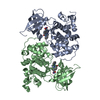

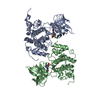
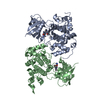
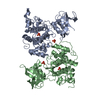

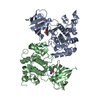
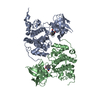
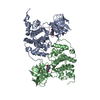

 PDBj
PDBj











